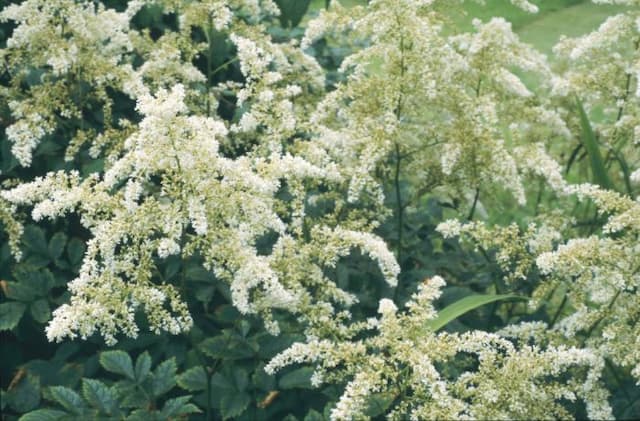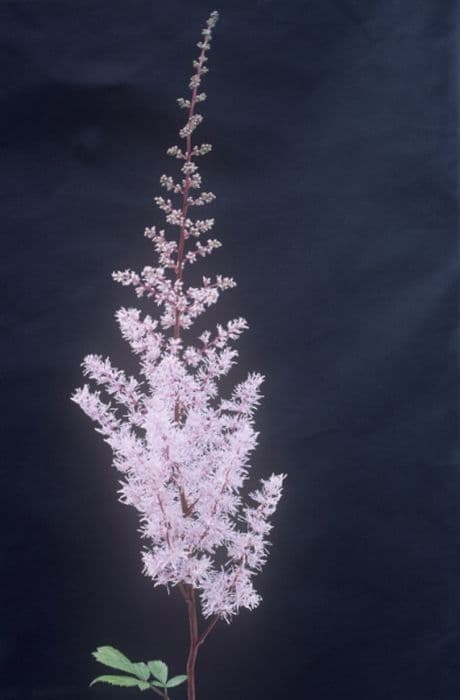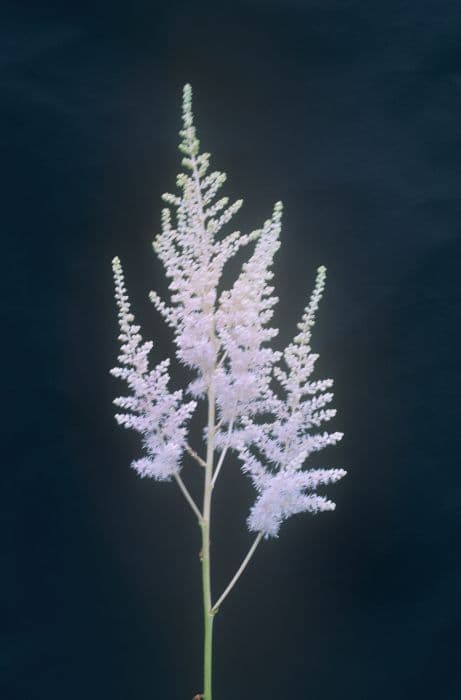Coral Bells Heuchera 'Midnight Rose'

ABOUT
'Midnight Rose' is a captivating variety known for its distinctive foliage. The leaves of 'Midnight Rose' are truly a standout with their almost-black, deep burgundy base color. Peppered across this dark canvas are splashes and splotches of hot pink to pale pink, resembling an abstract painting more than a living leaf. This variegation changes and intensifies with the seasons, starting out more subtly and becoming more vibrant as the plant matures throughout the growing season. The foliage is rounded with a slightly lobed and ruffled edge, giving it a delicate and textured appearance. In contrast to the dramatic foliage, 'Midnight Rose' blooms with delicate bell-shaped flowers, which emerge on tall stalks above the leaves in the late spring to early summer, adding another layer of visual interest to this ornamental plant. The flowers are typically a creamy white, though they are often considered secondary to the striking leaves. This plant is a perennial, which means it can return for several years to grace gardens with its colorful display.
About this plant
 Names
NamesFamily
Saxifragaceae.
Synonyms
Coral Bells, Alumroot.
Common names
Heuchera 'Midnight Rose'
 Toxicity
ToxicityTo humans
Coral Bells (Heuchera 'Midnight Rose') is not known to be toxic to humans. Therefore, ingestion of the plant should not cause adverse health effects or symptoms of poisoning in humans. However, it is always advised to avoid eating ornamental plants due to potential unknown reactions.
To pets
Coral Bells (Heuchera 'Midnight Rose') is generally considered non-toxic to pets such as dogs and cats. Ingesting this plant should not cause significant symptoms of poisoning. However, it is always best to prevent pets from eating plants as individual reactions can vary, and some pets may experience mild digestive discomfort if they consume non-food items.
 Characteristics
CharacteristicsLife cycle
Perennials
Foliage type
Semi-deciduous
Color of leaves
Mixed
Flower color
Pink
Height
1 feet 10-12 inches (25-30 cm)
Spread
1 feet 16-20 inches (40-50 cm)
Plant type
Herb
Hardiness zones
4-9
Native area
North America
Benefits
 General Benefits
General Benefits- Attractive Foliage: The Heuchera 'Midnight Rose' is known for its striking maroon-black leaves dotted with hot pink speckles, providing aesthetic appeal to gardens.
- Long-Lasting Color: This plant offers a long season of interest with evergreen foliage, maintaining garden color throughout the year.
- Low Maintenance: Heuchera 'Midnight Rose' is relatively easy to care for, requiring minimal maintenance once established in the proper conditions.
- Drought Tolerance: Once established, this plant exhibits some drought resistance, making it suitable for gardens with low water availability.
- Pest and Disease Resistance: The plant is relatively resistant to common pests and diseases, ensuring less effort in pest management.
- Compact Size: With its clumping habit and short stature, it is ideal for small gardens, borders, and as ground cover without overwhelming other plants.
- Attracts Pollinators: While the main appeal is its foliage, the subtle flowers can attract butterflies and other pollinators to the garden.
- Versatility: Heuchera 'Midnight Rose' can be planted in a variety of settings including rock gardens, woodland gardens, and in containers for patios or balconies.
- Shade Tolerance: This variety can thrive in partial shade, making it a good choice for areas of the garden that don't receive full sun.
 Medical Properties
Medical PropertiesThis plant is not used for medical purposes.
 Air-purifying Qualities
Air-purifying QualitiesThis plant is not specifically known for air purifying qualities.
 Other Uses
Other Uses- Artistic inspiration: Heuchera 'Midnight Rose' can be used as a subject for botanical illustration or garden photography due to its unique foliage.
- Educational tool: This plant can be included in horticultural classes to teach about hybridization and the development of new garden varieties.
- Culinary decoration: Although not typically consumed, the leaves can be used as a colorful garnish for salads and other cold dishes.
- Fairy gardens: The plant can be included in whimsical miniature fairy garden designs due to its striking foliage.
- Themed garden designs: 'Midnight Rose' can be used in 'gothic' or 'moonlight' garden themes because of its dark foliage.
- Container plant combinations: As a container plant, it pairs well with bright flowers or foliage to create contrast.
- Garden borders: It can be used to create an attractive and colorful edge along walkways or garden borders.
- Plant swaps: Heuchera 'Midnight Rose' is a desirable plant for exchanging among gardeners at plant swap meets.
- Ground cover: In large groupings, it can serve as an ornamental, low-maintenance ground cover in shaded areas.
- Seasonal decorations: The leaves can be integrated into fall floral arrangements or wreaths for their unique texture and color.
Interesting Facts
 Feng Shui
Feng ShuiThe Coral Bells is not used in Feng Shui practice.
 Zodiac Sign Compitability
Zodiac Sign CompitabilityThe Coral Bells is not used in astrology practice.
 Plant Symbolism
Plant Symbolism- Durability: Heuchera, also known as Coral Bells, is known for its hardiness and resilience, symbolizing strength and the ability to withstand tough conditions.
- Versatility: Coral Bells come in various colors and can grow in different climates, representing adaptability and versatility in life.
- Attraction: The 'Midnight Rose' variety, with its attractive dark foliage and pink speckles, often symbolizes enchantment and allure, drawing attention to its unique beauty.
- Festivity: With its bell-shaped flowers, Coral Bells can symbolize celebration and cheerfulness, bringing a sense of joy to gardens and landscapes.
 Water
WaterCoral Bells should be watered regularly, with the soil being allowed to dry out slightly between waterings to avoid over-saturation. They typically require watering approximately once a week, but this can vary depending on climate and soil conditions. A rough guideline for mature plants is to provide about one gallon of water per week, especially during hot and dry periods. Younger or newly planted Coral Bells may require slightly more frequent watering to establish a strong root system.
 Light
LightCoral Bells thrive best in part shade to full shade conditions. They can tolerate morning sun but should be protected from the harsh afternoon sunlight to prevent leaf scorch. The ideal spot for these plants is under the dappled shade of larger trees or in a garden area that receives filtered light. Too much sun can fade the foliage colors, while too little can reduce the plant's vitality.
 Temperature
TemperatureCoral Bells are hardy in a range of temperatures and can survive in USDA hardiness zones 4 through 9, which generally equates to minimum temperatures ranging from -30 to -20 degrees Fahrenheit. Their ideal growing temperature is between 60 and 70 degrees Fahrenheit during the day. However, they can tolerate higher temperatures as long as they are not in direct sunlight and have adequate soil moisture.
 Pruning
PruningCoral Bells require minimal pruning. Deadheading the spent flower stalks after blooming can encourage a tidy appearance and potentially a second, albeit smaller, bloom. Pruning dead or damaged leaves anytime during the year is also helpful to maintain the plant's health and appearance. The best time for more thorough pruning is early spring, just as new growth begins, allowing the removal of any winter-damaged foliage.
 Cleaning
CleaningAs needed
 Soil
SoilCoral Bells 'Midnight Rose' prefers well-draining soil rich in organic matter, with a slightly acidic to neutral pH of 6.0 to 7.0. A recommended soil mix would be one-part garden soil, one-part peat moss or coconut coir, and one-part perlite or coarse sand to improve drainage.
 Repotting
RepottingCoral Bells 'Midnight Rose' should be repotted every 2 to 3 years or when the plant outgrows its container. It's best to repot in the spring, just before the growing season begins.
 Humidity & Misting
Humidity & MistingCoral Bells 'Midnight Rose' grows best in average humidity levels. If indoor air is too dry, consider using a pebble tray with water or a humidifier but keep humidity moderate as overly humid conditions can promote rot.
 Suitable locations
Suitable locationsIndoor
Place Coral Bells 'Midnight Rose' in bright, indirect light indoors.
Outdoor
Grow Coral Bells 'Midnight Rose' in part shade, moist soil.
Hardiness zone
4-9 USDA
 Life cycle
Life cycleThe life cycle of the Heuchera 'Midnight Rose', commonly known as Coral Bells, begins with seed germination, occurring in warm, moist soil conditions with a thin layer of soil or compost to cover the seeds. Seedlings emerge and develop into rosettes of colorful, variegated foliage, with each rosette capable of growing independently. As the plant matures, it produces a sturdy, upright stem that yields delicate bell-shaped flowers on tall, slender stalks in late spring to early summer. After blooming, seeds form and are dispersed for the next generation, or the plant may spread vegetatively through underground rhizomes. Throughout the growing season, Coral Bells exhibit vigorous foliage growth, until dormancy in late autumn or winter when the plant's above-ground growth dies back. The cycle resumes in spring as the warmth and light trigger new foliage growth and prepare the Coral Bells for another flowering season.
 Propogation
PropogationPropogation time
Spring-Early Summer
Heuchera 'Midnight Rose', commonly known as Coral Bells, is typically propagated by division, which is best done in spring as new growth begins. To propagate by division, carefully dig up the parent plant and gently separate the crown into smaller sections, each containing at least one shoot or bud and a portion of the root system. These divisions can then be replanted at the same soil level as the original plant, spaced about a foot (approximately 30 centimeters) apart to allow sufficient room for growth. Water the new divisions thoroughly after planting to help establish them. This method is quick, generally reliable, and helps to maintain the variegated patterns of the 'Midnight Rose' foliage, ensuring that the new plants are true to the parent in form and color.









